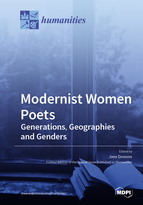Modernist Women Poets: Generations, Geographies and Genders
A special issue of Humanities (ISSN 2076-0787).
Deadline for manuscript submissions: closed (1 November 2019) | Viewed by 45837
Special Issue Editor
Interests: women's poetry; contemporary poetry; postcolonialism; women’s writing; modernism and the 1930s
Special Issues, Collections and Topics in MDPI journals
Special Issue Information
Dear Colleagues,
Feminist scholars have crucially proved that female poets count in orthodox categories of High Modernism. We have demonstrated their centrality to intellectual Anglo-American [‘Eliotic’] experimentation that fed into and from the European avant-garde. Into the twentieth-first century, modernist projects shy away from the exclusions of a capitalized monolithic Modernism that was bound by a narrow interwar period, linguistic abstruseness, and masculinized cultural imperialism. Instead, modernist studies have been enriched by pluralizing chronologies, styles, and locations. We now have categorization through generations or a non-periodizing intermodernism, the anti-elitist middlebrow, and postcolonial geomodernisms. Accordingly, this Special Issue aims to discuss poets who enhance the breadth of modernist literary practices while maintaining modernism as a meaningful and identifiable aesthetic. Thus, we shall take as the cohering concept a complex relationship to gender and to modernity that manifests in a self-consciously complex treatment of language. We hope to explore writers across the generations that modernist histories now recognize: Gertrude Stein’s contemporaries, born around the cusp of the twentieth century and flourishing during the 1920s and 1930s; the next generation who came to their peak in the 1950s and include Elizabeth Bishop or Stevie Smith; and the third generation who published into the 1980s. While we welcome new gender-based approaches to the now prominent American innovators, Millay, Moore, HD, Lowell, and Loy, we hope for essays that attend to more explicitly female-centred work of, say, Denise Levertov or Charlotte Mew. We particularly want contributions that delve into intersectional identities and literature beyond the Anglo-American framework, by such writers as Anna Akhmatova, Angelina Weld Grimké or M. NourbeSe Philip. Each essay will take account of recent critical work and illuminate how the poet or poets fashion an aesthetic concerning their lives and professions as women writers in a turbulent time.
Dr. Jane Dowson
Guest Editor
Manuscript Submission Information
Manuscripts should be submitted online at www.mdpi.com by registering and logging in to this website. Once you are registered, click here to go to the submission form. Manuscripts can be submitted until the deadline. All submissions that pass pre-check are peer-reviewed. Accepted papers will be published continuously in the journal (as soon as accepted) and will be listed together on the special issue website. Research articles, review articles as well as short communications are invited. For planned papers, a title and short abstract (about 100 words) can be sent to the Editorial Office for announcement on this website.
Submitted manuscripts should not have been published previously, nor be under consideration for publication elsewhere (except conference proceedings papers). All manuscripts are thoroughly refereed through a double-blind peer-review process. A guide for authors and other relevant information for submission of manuscripts is available on the Instructions for Authors page. Humanities is an international peer-reviewed open access semimonthly journal published by MDPI.
Please visit the Instructions for Authors page before submitting a manuscript. The Article Processing Charge (APC) for publication in this open access journal is 1400 CHF (Swiss Francs). Submitted papers should be well formatted and use good English. Authors may use MDPI's English editing service prior to publication or during author revisions.
Keywords
- Twentieth-Century Women Poets
- Modernist women writers
- Feminist literature
- Intersectional feminism
- Geomodernism
- Intermodernism
- Middlebrow
- Postcolonial poetry
- Gertrude Stein
- Marianne Moore
- Edna St Vincent Millay
- H.D.
- Mina Loy
- Elizabeth Bishop
- Charlotte Mew
- Denise Levertov
- May Sinclair
- Anna Akhmatova
- Angelina Weld Grimké
- M. NourbeSe Philip
- Edith Sitwell
- Stevie Smith






